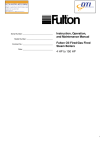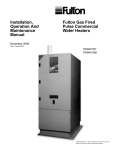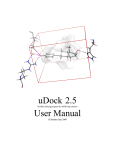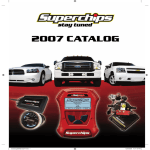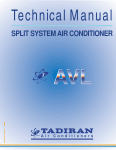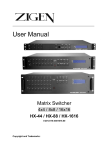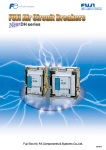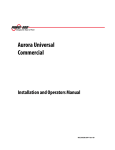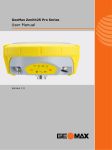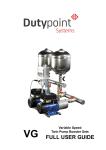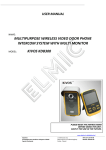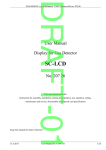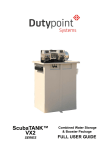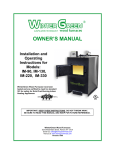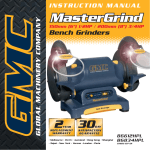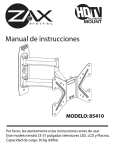Download Instruction, Operation, and Maintenance Manual Fulton Oil Fired
Transcript
Serial Number: _______________________________ Instruction, Operation, and Maintenance Manual Model Number: ___________________________ Contract No.: _______________________________ Date: _______________________________ Fulton Oil Fired/Gas Fired Hot Water Boilers 4 HP to 150 HP 1 Instruction This manual is provided as a guide to the correct operation and maintenance of your Fulton Oil Fired/Gas Fired Boiler, and should be permanently available to the staff responsible for the operation of the boiler. These instructions must not be considered as a complete code of practice, nor should they replace existing codes or standards that may be applicable. The requirements and instructions contained in this section generally relate to the standard Fulton Oil Fired/Gas Fired Hot Water Boiler. When installing a packaged unit, this entire section should be read carefully to ensure that the installation work is carried out correctly. Prior to shipment the following high standard tests are made to assure the customer has the highest quality of manufacturing: a) Material inspections. b) Manufacturing process inspections. c) Welding inspections. d) Hydrostatic test inspection. e) Electrical components inspection. Under no circumstances should weight be allowed to bear on the jacket, control panel, or fan housing of any Fulton Boiler. The customer should examine the boiler for any damage, especially the refractory. Rigging your boiler into position should be handled by a experienced in handling heavy equipment. f) Operating test. g) Final Inspection. We reserve the right to change for improvement without notice. h) Crating inspection. All units can be transported with forklift. . 2 Content Section 1 2 Safety Warnings Cautions and Notes 3 Operation 4 Maintenance 5 Parts Description/Instructions Specifications & Dimensions 4HP-150 HP Locating the Boiler The Fuel Oil Supply The Gas Supply Water Supply Boiler Installation Electrical Requirements Fresh Air Supply for Boiler Room Conventional Venting Exhaust Side Wall Venting Combustion Air Intake Corrosion of Flue Pipe Installation Checkpoints Cleaning the Pressure Vessel Starting the Boiler Oil Burner Set Up Gas Burner Set Up Primary Air Adjustment Secondary Air Adjustment Boiler Controls Cyclic Pump Switch General Primary and secondary Air Adjustment Draft Transformer Flame Rod Adjustment Flame Scanner Adjustment Oil Supply Oil Nozzle Oil valve Temperature control Cad Cell Test for Burner Circuit Pump Circuit Check Cyclic Control System Replace Handholes Gaskets Clean Burner Assembly Stainless Steel Combustion Ring Dirty Flue Furnace Refractory Replacement Procedure Trouble shooting Oil Burner and Ignition Assembly Components Gas Burner and Ignition Assembly Components 3 Content Sketch of Layout for Boiler Room 6 Warranty Files Card for Fulton Boiler Users Guarantee Card of Fulton Boiler 4 Safety Warnings Cautions &Notes 5 Safety Warnings Cautions &Notes Safety Warnings, Cautions & Notes The following WARNINGS, CAUTIONS, and NOTES appear in various chapters of this manual. They are repeated on these safety summary pages as an example and for emphasis. WARNINGS must be observed to prevent serious injury or death to personnel. CAUTIONS must be observed to prevent damage or destruction of equipment or loss of operating efficiency. NOTES must be observed to keep boiler being operated with high efficiency. It is the responsibility and duty of all personnel involved in the operation and maintenance of this equipment to fully understand the WARNINGS, CAUTIONS, and NOTES by which hazards are to be reduced or eliminated. Personnel must become thoroughly familiar with all aspects of safety and equipment prior to operation or maintenance of the equipment. NOTE After installation is completed and prior to operation the pressure vessel should cleaned. CAUTION Do not store halogenated hydrocarbons near or in the boiler room. NOTE a) The fused disconnect switch that controls the feed water pump should be kept in the “on’ position at all times during the boiler operation as well as during the non-operating period of the boiler. To ensure that your Fulton Hot Water Boiler is kept operating b) This switch should be turned “off” only when repairs or adjustments should be made. safely and efficiently, follow the maintenance procedures set froth in Section 4 of this manual. CAUTION NOTE Do not tamper with the safety features of the low water safety cut off. NOTE The flame scanner is located on the outside edge of the burner top plate for 20HP-150HP. NOTE WARNING Before the boiler is operating: a) Check all of the electric connections in the panel box are firm. b) The content of each chapter in this manual must be understood first. NOTE Check the effect of installation, including: a) Requests for electric wire and voltage. b) Fresh air supply. c) Oil or gas line and oil or gas supply. CAUTION When stopping the boiler for any extensive repairs, shut off main disconnect switches on both the boiler side as well as the feed water side. The bottom refractory must not be damaged when the top refractory is replaced as necessary NOTE Fulton recommends that feed water treatment should be performed before it is added into the boiler. WARNING Make sure main power switch is off before starting work. NOTE After a new Fulton Boiler has been in operation for several months, pieces of burned metal will be found in the space at the bottom of the boiler. These pieces of metal act as the formed combustion ring effect during manufacture. This is a normal condition and does not affect the efficiency and the life of the boiler in any way. 6 Operation 7 Operation 8 Operation Specifications Standard Models FBB 4 6 10 15 20 30 40 50 60 80 100 130 150 Boiler HP 4 6 10 15 20 30 40 50 60 80 100 130 150 158 236 399 593 793 1191 1586 1983 2382 3174 3569 4760 5550 4 6 10 15 20 30 40 50 60 80 90 120 140 Ratings (sea level to 914m)* Output(steam) 1000Btu/Hr 10000Kcal/Hr Hot water Rating kg/Hr 1333 2000 3333 5000 6666 10000 13333 16666 20000 25000 30000 40000 46667 Light diesel oil ** kg/h 4.30 6.45 10.76 15.22 20.29 30.44 40.58 50.73 60.88 74.40 89.29 119.05 137..36 3 Ft. /h 2.14 3.21 5.35 7.58 10.10 15.15 20.20 25.25 30.30 37.04 44.44 59.26 68.37 3 Ft. /h 5.41 8.12 13.54 19.15 25.54 38.30 51.07 63.84 76.61 93.63 112.36 149.81 172.86 3 13.77 20.65 34.42 48.70 64.94 97.40 129.87 162.34 194.81 238.10 285.71 385.95 438.46 Propane gas Natural gas Town gas Ft /h Natural gas boiler IN 1 1 1 1 1.25 1.5 1.5 1.5*** 2 2.5 3 3 3 Connection size mm 25 25 25 25 32 38 38 38 50 64 76 76 76 GAS OIL GAS OIL GAS OIL GAS OIL GAS OIL GAS OIL GAS OIL GAS OIL GAS OIL 4 4 Burner Motor HP 3450RPM/60CY 2850RPM/50CY 1/3 1/3 1/3 1/3 1 1/3 3/4 1/3 3/4 1 /2 2 1 1 1 /2 2 1 /2 2 2 3 2 3 5 Electric Power Requirements (In Amps) 220V/50CY/1Phase 3.5 3.5 3.5 3.4 5.3 5.3 - - - - 380V/50CY/3Phase - - - - - - 3.7 3.7 3.7 4.6 Control voltage 220V/50CY/1Phase 2 2 2 2 2 2 2 2 2 2 - - - 4.6 6.2 6.6 2 2 2 8 8 2 2 Notes: 3 3 **Fuel consumption based on Light oil 11200 kcal/kg, propane gas 22500kcal/ m , Natural gas 8900 kcal/ m , Town gas 3500 3 kcal/ m . ***2 inch IRI and CSA. We reserve the right to change specifications and /or dimensions for improvement. 9 5 Operation 10 Operation Dimensions and Weight Boiler HP 4 6 10 15 20 30 40+ 50 60 80 100 130 150 Minimum Clearance A. The Front of The Boiler IN mm 41 1041 41 1041 41 1041 41 1041 41 1041 41 1041 41 1041 41 1041 41 1041 41 1041 41 1041 41 1041 41 1041 B. Sides & Rear of Boiler IN mm 36 915 36 915 36 915 36 915 36 915 36 915 36 915 36 915 36 915 36 915 36 915 36 915 36 915 Clearance Required for IN Burner Removal mm 72 1828 82 2083 86 2184 92 2337 96 2438 106 2692 104 2641 114 2896 124 3150 126 3200 129 3277 151 3835 157 3988 Height and Width D. Height of Boiler IN 47 57 63 69 72 82 73.5 87 93 93 99 117 117 mm 1194 1448 1600 1753 1829 2083 1867 2210 2362 2362 2515 2972 2972 E. Boiler Height with Trim IN. and fuel train assembly mm 65 1651 75 1905 80.5 2045 86.5 2197 92.5 2350 102 2591 94 2388 106.5 2705 120 3048 122 3099 125 3175 135 3430 141 3582 F. Boiler Diameter IN 26 26 28 30 39 46 55 55 55 63 68 76 76.5 mm 660 660 710 760 990 1170 1400 1400 1400 1588 1740 1936 1943 G. Overall Depth (Stack IN to Burner Fan Housing) mm 44 1118 44 1118 46 1168 47 1194 60 1524 67 1702 73 1854 78 1981 78 1981 90 2280 120 3043 134 3395 136 3455 Boiler connections H. Hot Water Outlet IN. Diameter I. Return Water Inlet Diameter J. Return Water Inlet Height K. Return Water Inlet Length L. Return Water Inlet Depth M. Boiler Blow Off Outlet Diameter N. Flue outlet Diameter 1.5 1.5 2 2.5 2.5 3 4 4 4 4 4 5 5 mm 40 40 50 65 65 80 100 100 100 100 100 125 125 IN mm 1.5 40 1.5 40 2 50 2.5 65 2.5 65 3 80 4 100 4 100 4 100 4 100 4 100 5 125 5 125 IN 15.5 15.5 16 16.25 17.25 17.5 18.75 18.75 18.75 20.16 20.16 23.7 23.7 mm 394 394 406 413 438 443 476 476 476 512 512 603 603 IN mm 18 457 18 457 19 483 20 508 23 584 26 660 30.5 775 30.5 775 30.5 775 33.5 851 37.5 953 36.8 935 36.8 935 IN 6.25 6.25 7.25 7.88 11.75 14.8 18 18 18 24 27 30 30 mm 159 159 184 200 299 375 457 457 45 610 686 760 760 IN. 1 1 1 1 1.25 1.25 1.5 1.5 15 1.5 1.5 2 2 mm 25 25 25 25 32 32 40 40 40 40 40 50 50 in. 6 6 6 8 10 12 12 12 12 14 14 16 16 mm 152 152 152 203 254 305 305 305 305 356 356 400 407 O. To Center of Flue Outlet in. mm 42 1070 52 1320 58 1473 63 1600 66 1675 73.5 1867 65 1651 79 2007 85 2159 95 2423 95 2423 107 2723 110 2794 P. Safety Valve Diameter 0.75 0.75 0.75 0.75 1 1 1.25 1.25 1.25 1.5 1.5 2 2 20 20 20 20 25 25 32 32 32 40 40 50 50 14 53 16 61 24 91 39 148 77 292 170 643 220 835 245 927 270 1022 375 1419 580 2195 876 3317 904 3423 LB 1400 1700 2000 2280 3400 4780 6400 6526 7280 10506 11608 15418 15550 KG 640 770 910 1035 1545 2170 2905 2963 3305 4770 5270 7000 7060 IN mm Water Content U.S.GAL LITERS Weight Approx. Shipping Weight Note: 1. Input foreign original boiler feed water pipe: connect with screw; the civil assembly ones are all flanged. 2. There is a spare safety valve connection for 40-150HPboilers. 3. We reserve the right to change the specifications and dimensions for improving our products. 11 Operation Locating the Boiler a) The boiler should be located in dry surroundings on a level base, making sure that there is sufficient room around the boiler to enable the operator and/or the maintenance engineer to gain access to all parts of the boiler. Check location for ease of water supply and electrical connections. b) Place the boiler on a noncombustible floor with clearances to unprotected combustible materials, including plaster or combustible supports. c) It is necessary to have the sufficient clearance from the boiler to the oil tank for oil fired boiler. The Fuel Oil Supply a) Be sure that the oil supply lines from the tank to the burner are of proper size. Vacuum should not exceed 10” of mercury at the oil pump inlet (including pipe line etc. total resistance). It is suitable that the height of pump inlet is 500mm higher than oil tank outlet when install. b) All Fulton oil burners are of the two pass design system requiring a return line and supply line. The oil pump is factory set at 230 psi (=16 Kg/cm2). Do not change this setting without allowance of Fulton Boiler.. c) A stop valve, a check valve, and an oil filter must be installed in the oil supply line.(The filter set position must be capable of draining gas in filter and pipe line completely.) d) When one oil line is feeding two burners, a check valve ( low resistance) must be installed in each unit. e) Make sure there are no loose fittings. Loose fittings in the fuel oil line will allow air to enter into the fuel line and cause improper firing. The Gas Supply a) Gas piping should be installed in accordance with National Fuel Gas Code, and any other local codes which may apply. b) Install a dirt trap and sink blow off outlet ahead of all the gas valves. c) The pipe and the fittings used must be new and free of dirt or other deposits. d) The piping must be of the proper size to ensure adequate gas supply to the gas head assembly. Consult your gas company for specific recommendations. e) For natural gas a pressure of 7” to 11” (178mm to 279mm) of water column pressure at the gas train is required with burner firing. Do not exceed 13” of water column. f) For propane or butane gas the pressure required is 11”(279mm) of water column pressure. Again, do not exceed 13” of water column. g) When making gas piping joints, use a compound to seal the gas line treads. Do not use Teflon tape on gas line threads. h) The main and the pilot gas pressure regulators must be vented to the atmosphere. i) After gas piping is completed carefully check all piping connections, for gas leaks. Use a soap and water solution. Caution Some matters used for leak testing are corrosive to certain types of metals. Rinse all piping thoroughly with clean water after leak check has been completed. j) The boiler must be disconnected at the boiler shut off valve from the gas supply piping system when intake gas pressure is in excess of 14”W.C. k) The boiler must be isolated from the gas supply piping system by closing the shutoff cock during any pressure testing of the gas supply piping system at pressure equal to or less than 1/2 PSIG-14”W.C. Water Supply NOTE Feedwater will affect the life of the boiler, it is recommended that suitable water treatment should be considered before the boiler is installed (including scale or oxygen corrosion), for the damage caused by water is not covered in the warranty. Boiler Installation Read carefully this manual before installation, see installation, adjustment assistant documents, and referenced sketch layout of boiler room enclosed in “components” tables. a) Connect return tube with feed water inlet at the back of boiler, fit hot water stop valve between boiler and equipment. Use pipe line to joint hot water outlet with equipment requiring water. If cool water system is installed, the hot water inlet must be connected with cool water system and return water. b) Connect the safety valve to outlet at left side of the boiler through pipe, from safety valve pipe to safety drain point. c) Do not change water temperature pressure gauge assembly at any time. d) the blow off valve must be 12 Operation connected to the lowest outlet at the rear bottom of boiler, from valve outlet pipe to safety blow off point. e) There should preset sufficient space around the boiler for maintenance to blow off vale and electric control panel box by professional personnel. Electrical Requirements a) Power supply must be in accordance with section 5 “Parts” table . b) Connect wiring as shown in the wiring diagram which is furnished inside the electrical control panel box. Be sure to install a separate fused switch for fan motor and cycle pump. If the power of pump motor equal to or more than 3/4 hp, it is recommended to install a separate start switch ahead of the cycle pump. c) Use fused switch of proper size, and the position should be as close as possible to the boiler, the fire prevention and control code and others must be fulfilled at the same time. There is preset a tip for joint in the electric panel box, but hole is still need to be drilled on the panel box for pilot pipe to pass through. d) Connections for an optional : 220v audible alarm are provided in the control panel and are clearly indicated on the diagram. Fresh Air Supply for Boiler Room a) It is most important to provide free access of air to the boiler. 6.4cm2 is needed for every 756 Kcal). b) Proper ventilation of the boiler room is essential for good combustion. Install two fresh air openings, one at a low level of 610mm from floor and one at a higher level on the boiler room (See the picture). This will provide a flow of fresh air intake into from the bottom hole and exhaust the hot air from the top hole. c) The following openings are recommended for each size boiler: Make UP Air Openings BHP 4 6 9.5 15 20 30 40 50 60 80 100 130 150 BT² 1 1 1 4 4 5 5 5 7.5 12.5 16 20 23.5 NOTE M² 0.09 0.09 0.09 0.37 0.37 0.46 0.46 0.46 0.69 1.11 1.49 1.86 2.19 These measurements are subject to local regulations. The installation of exhaust fans in a boiler room is not recommended. An exhaust fan, or similar equipment can create down draft in the stack or restrict the burner’s air supply which will result in poor combustion. It is essential that only fresh air is allowed to enter the combustion air system. Foreign substances, such as combustible volatiles and lint, in the combustion system can create hazardous condition 。 13 Operation Conventional Venting (in accordance with the local fire prevention and control code) a) The stack should rise continuously to the connection with the chimney, and should contain no more than two bends at 45 angles or less. If required as the result of space limitations, one 90 elbow can be fitted at the back of the boiler. There should be two feet of straight, horizontal flue before any bends or turns. Any alternative stack arrangement must supply -.02 -.04” W.C. pressure burner off. b) The total horizontal run of the boiler stack should not exceed 70% of the total vertical rise. c). The stack and chimney must be constructed from material that is rated for 532 degrees C operating temperature. Check all local codes for exact requirements. d) Adequate provision must be made for the support of the weight of the chimney and stack to avoid having too great a load imparted to the flue outlet connection of the boiler. e) The proper flue size and draft control is most important for proper burner operation. The flue must be as large or larger than the outlet on the boiler. Avoid flue piping too long and elbows too much by placing the boiler as close as possible to the chimney. f) A mechanical draft regulator may need to be installed in the flue outlet. Do not install the draft regulator prior to the first turn of the flue. g) The installer should check the draft with a meter at -0.02 -0.04” W.C. pressure with the burner off, and -0.04 to -0.06 W.C. pressure with the burner on. BHP Boiler Flue Size Inches Millimeters 4 6 152 6 6 152 9.5 6 152 10 6 152 15 8 203 20 10 254 30 12 305 40 12 305 50 12 305 60 12 305 80 14 356 100 14 356 130 16 400 150 16 400 14 Operation Exhaust Side Wall Venting (In accordance with the local fire prevention and control code) Boilers for which sidewall venting may be utilized are oil, , natural gas, or gas/oil, sizes 4 to 30HP.The following criteria is required for installations using sidewall venting. 1) Flue vent piping shall be pitched upward at 1/4" per foot of length. 2) A U.L. approved draft fan must be installed to provide sufficient draft to safely vent the products of combustion. 3) The draft fan should be located as close to the flue outlet as possible. 4) Draft regulation sufficient to lower the draft to between -0.02 to -0.04 " W.C. pressure may be required. The draft regulator(s) must be between the boiler and draft fan. 5) The draft fan shall have an air flow proving switch wired in series with the boiler air safety switch. 6) The sidewall venting total length from boiler exhaust to termination shall not exceed 35 feet (10.7 m) with 4 elbows maximum. 15 Operation Combustion Air Intake (In accordance with the local fire prevention and control code ) This shall be applicable only for gas fired vertical units, sizes 4-30 boiler horsepower. The following criteria are required for installations using combustion air intake assemblies. 1) Outside air intake inlet shall be equipped with a vent cap in order to prevent flame blow out from excessive wind. This vent cap shall have a minimum cross sectional opening equal to an 8 inch vent pipe. 2) All intake ducting shall have a cross sectional area equal to or greater than 50 square inches. 3) A mesh screen shall be affixed to the air inlet with openings of approximately 1/2" x 3/4". 4) The total length from outdoors to the boiler intake shall not exceed 35 feet (10.7 m) with four elbows maximum. combustion system flue line increases in temperature, the water vapor no longer condenses because the flue temperature is above the dew point of the combustion gas. The combustion gas then dries out (dehydrates) the hydrochloric acid solution leaving behind dry chloride salt. b) When the next cold start-up occurs, the process repeats except that more and more chloride collects and concentrates along the flue. As the quantity of chloride increases it does not dehydrate completely as the flue heats up and a corrosive poultice develops which attacks the steel and will also attack the boiler. c) Concentration levels of only a few ppm of chlorine containing compounds in combustion air can produce serious corrosion over long periods of time. High chlorine containing compounds such as carbon tetrachloride or perchloride would be prime suspects. a) After the boiler has been installed and before it is placed in service it is advisable to purge the pressure vessel of any oil film, dirt, or other impurities. Clean the pressure vessel as follows: 1) Isolate the boiler from the system by shutting off the water outlet valve. 2) Remove the safety valve. 3) Mix washing soda with water r and pour it into the boiler through the safety valve opening. 4) The mixture of washing soda to water is as follows: Boiler Size Soda 4-6 10-15 20-30 1lb(454g) 2lb(908g) 3lb(1362g) 40-50 60 3-1/2ib(1589g) 4lb(1816g) 80 100-130 5lb(2270g) 7lb(3178g) 150 4250g Installation Check Points Corrosion of flue pipe a) In the case of a combustion flue pipe, acid may develop over a long period of time per the following process. Chlorine containing gases, such as halocarbon refrigerants, carbon tetrachloride, trichloroethylene, when drawn into combustion air are broken down into elemental chlorine gas which exits up the flue pipe. If the flue pipe is cold, as it would be if the combustion process had been off for some time, the water vapor condenses in the flue pipe during the first few minutes of ignition and the chlorine in the combustion gas dissolves in the water forming hydrochloric acid. As the 1) Make sure all piping connections are complete and tight. 2) Make sure the temperature controls are adjusted properly. 3) Make sure all electrical connections in the control panel box, the low water probe, and elsewhere are secure. 4) Make sure the door in the boiler room is closed. Combustion air contaminates can cause damage to the boiler jacket and stack. NOTE After installation is complete and prior to operation the pressure vessel should be cleaned. Cleaning the Pressure Vessel 5) Replace the safety valve. 6) Fill the boiler with water until the low water relay close. If water has been flowing from the drain valve , press the electric panel box reset button. 7) Shut off the boiler when temperature reaches 80 degree of C. Allow this hot solution to remain in the boiler for 10 minutes. 8) Drain and flush the boiler twice with fresh water. 9) To remove all the oil and dirt from cycle pipe line and heat exchanged equipment, cyclic clean by add suitable soda should be considered as well. 16 Operation CAUTION Before start the boiler: a) Check if all the wiring of circuit in electric panel box for the boiler are fixed. Do not store halogenated hydrocarbons near or in the boiler room. In general, ensure that the boiler area is in conformance with established boiler room requirements. Review local codes. As a final checkpoint, again, water treatment. Here we emphasize the importance of proper water treatment. Water analysis should be made by a competent water treatment concern and their recommendations should be followed. b) Be sure that the operating person have read all the chapter s in this manual and understand completely. Boiler Accessories 2) Remove the safety valve The following accessories are supplied when output: ( some may be pre-fit ) Item Quantity Temperature 1 Pressure Gauge Low Water Probe 1 Safety Valve 1 Operation 1 Temperature Control Limit 1 Temperature Control 3) Inject soda water Blow Off Valve 1 WARNING 1) Shutting off the water outlet valve 17 Operation 18 Operation The follows are operation instructions for Fulton hot water boilers. If user do not operate as these instructions, we reserve the right to not cover it. Starting the Boiler Stop! Make sure you have read any followed all previous safety information. Carry out the following procedure on the initial start up of the boiler and on every subsequent occasion when restarting the boiler after a shut down. 1). Open the return water valve. 2) Open stop valve on top of the boiler.(supply hot water system) 3) Open makeup water valve. 4) Fill in water into boiler and system.(During filling, the overflow valve must be fully open to exhaust all the air. When water flows out from the overflow valve, the boiler and system must be filled completely.) Place feedwater pump fused switch in the “on” position. 5) Shut off main power switch. 6) the IDIDO will be activated. Press the reset button as necessary. 7) The IDIDO will be activated when the boiler is filled with water, the low water relay then shut automatically.8) If for any reason ,water level separates from the low water probe, boiler will shut off automatically and start alarm (if fitted). 19 Operation Oil Burner Set Up a) Open the oil line shut off valves. b) Switch on the main power to the burner. Depress the manual reset button on the panel box. c) To start the burner, turn on the switch located on the panel box. The blower motor will now start to deliver the air into the furnace. After the blower starts about 7 to 30 seconds, the magnetic oil valve is energized allowing the oil pump to deliver fuel to the furnace where it is ignited. 15-60HP Fuel Oil/ Gas MEC230 series Control panel d) On Fulton 4-15HP oil fired boilers, the burner control sights the fire from a cadmium sulfide photocell located on top of the burner. If it does not detect the flame in approximately 15 seconds, it will go out on safety lockout and shut down the burner. e) On Fulton 20-150 HP oil fired boilers, the flame safeguard control sights the fire from an ultraviolet scanner located on top of the burner. There will be a first stage pilot before the main oil valve is energized. After flame is proven the main oil valve will come on. If flame is not proven, it goes into safety shut down. 15-60HP Fuel Oil Siemens series Control panel Note: 4-20 BHP have only one stage. 30-150 BHP have two. f) Reset by depressing the button on the flame safeguard control. If boiler does not respond after 3 attempts, contact your authorized Fulton Representative. g) The main air control shutter is adjacent to the oil pump and should be adjusted so as to give a clean burning fire without excess air being delivered to the burner. h) The secondary air control is an L type handle located on the top of the burner scroll which controls the amount of the air that is delivered over the oil nozzle. This should be adjusted to keep the fire from backing up into the blast tube. i) Make sure the secondary air damper is locked after adjustment. j) Lock into position the main air control shutter. k) After the oil has been ignited in the burner, it will be controlled through the temperature control in the panel box which should be adjusted to suit the boiler application. 15-60HP Fuel gas Siemens series Control panel 80-150HP Fuel Oil(Left) Gas(Right) Siemens series Control panel 20 Operation Gas Burner Set Up a) Open the manual gas cocks on the pilot and main lines of the gas head. b) Switch on the main power to the burner. The water level relay is equipped with a manual reset. Depress the button on the box. programmer control will open the contacts and shut off the burner. Push the reset button on the control to reset. If trouble persists, it may be necessary to check the flame rod setting or the UV scanner. See Maintenance Section 4 for procedure to check flame rod setting or UV Scanner. c) The flame programmer is the main control in the panel box. The programmer in conjunction with a sensing device, either a flame rod or a UV scanner, "supervises" the ignition sequence - proves the flame is satisfactory, and finally "monitors" the established flame. Should any fault occur, either during the ignition sequence or during normal running, the programmer will immediately go to "lock-out" and the burner will shut down. d) When the pilot flame is established, the flame rod (or ultra-violet scanner) senses the voltage which is created in the flame between the flame rod and the gas nozzle. This signal is transmitted back to the flame programmer which opens the main gas valve giving a main flame. UV Scanner fit with 20-150HP Boilers Primary Air Adjustment for Fulton Gas Fired Boilers a) The primary air adjustment or main air control is located at the fan housing face. This control is used to supply the burner with excess air needed to facilitate good combustion. Too much or too little air will result in poor combustion. It is important to make sure the lowest level of excess oxygen is present while still maintaining a high level of carbon dioxide and negligible carbon monoxide. Using a CO2 or O2tester it is possible to determine the percent of excess air in the combustion mixture. b) On a No.2 oil fired boiler the excess oxygen should be 4 percent with 11 percent carbon dioxide. A smoke test is the best means to check for combustibles in the flue gases. A smoke test of 0-2 is an acceptable level. It is best to measure the flue gas with the stack in excess of 216 degree of C. To increase the oxygen in the burner open the air adjustment to the right. To close or reduce the oxygen in the burner , move it to the left. e) Fulton 4 - 30 HP. natural gas fired boilers can be equipped with flame rods or UV scanners. f) All Fulton propane or butane boilers and more than 50HP Fulton natural gas boilers are standard furnished with UV Scanners. If the installation is new or the burner has been disassembled, the burner may not fire at the first attempt due to air which must be purged from the gas lines. This will result in the burner flame programmer going to lockout. Repeat the procedure for starting the burner. The main gas valve will remain open as long as there is a demand for heat and the flame is carrying a sufficient signal to the flame programmer. Flame rod fit with 4-30HP Boiler Primary Air Adjustment is located at the fan housing face. If the flame is not established at the start, the safety switch in the flame 21 Operation Secondary Air Adjustment Procedure a) The secondary air control adjustment is located on the top, right hand side of the burner assembly. This damper type air controller is used to introduce air to and through the blast tube of the burner. The purpose of the primary air adjustment is to proportionately divide the air to the center or outer and center of the blast tube area. On most boilers the damper is locked in a wide open position. However, if it is necessary to close the damper, care should be taken to close the damper slowly and no more than 1/4 of the distance of the swing of the damper assembly. b) A visual examination down the blast tube should reveal that no process to maintain proper air fire chamber. mixtures between the outer surface heat, flames or fumes are backing up through the burner plate area. If they are the damper must be opened up once again. Failure to remove the flame or gases from the blast tube area will result in severe backfires as well as cause premature failure of electrodes, flame rods, and other burner components. hot water temperature of the boiler. b) Low water protective probe-Cut off the units when water level is too low. Low water control relay is located on the right top in the panel box. If equipped with manual reset controller, it must be shut off. c) Boiler operation temperature controller—Control water temperature automatically to operate at determined ranges Secondary Air Adjustment for 40-150HP d) Boiler limit temperature controller—When boiler output water temperature is exceed the determined data, the boiler shut down and need manual reset. Cyclic Pump Switch Secondary Air Adjustment for 4-30HP fire chamber with less air going down the blast tube area. By pulling the damper open more air is forced down the blast tube and less on the outside wall of the deflector face and fire chamber. By moving the damper closed, the air is forced to the outside of the It is important in the combustion c)A visual inspection down the view port should also show the fire completely covering the furnace walls. If the fire is tunneling down or is not to the outside wall of the furnace , the efficiency will drop off .Close the secondary air damper until tunneling stop. Boiler can be operated and has the following auto-control a) Pressure/temperature gauge—To show the pressure and a) The fused switch to control cyclic pump must be in off position at all the time. b) the circuit for cyclic pump is laid by user. NOTE To ensure that your Fulton Boiler is kept operating safety and efficiently, follow the maintenance procedures set forth in section 4 of this manual. 22 Maintenance 23 Maintenance 24 Maintenance Prior to the commencement of any work requiring the removal of cover plates and the opening of control panel box, the electrical supply must be disconnected. The General a) Keep boiler clean outside and inside with no dirt deposited. b) Check power and circuit wiring tightness periodically. c) Take annual examination by competent professional person. d) Fit with water treatment as necessary. e) Check temperature pressure gauge periodically to ensure it is in accordance with temperature controller. Primary and secondary adjustment-oil and gas air a)The secondary air control adjustment is located on the top, right hand side of the burner assembly. This damper type air controller is used to introduce air to and through the blast tube of the burner. The purpose of the primary air adjustment is to proportionately divide the air to the center or outer fire chamber. By moving the damper closed, the air is forced to the outside of the fire chamber with less air going down the blast tube area. By pulling the damper open more air is forced down the blast tube and less on the outside wall of the deflector face and fire chamber. b) It is important in the combustion process to maintain proper air mixtures between the outer surface and center of the blast tube area. On most boilers the damper is locked in a wide open position. However, if it is necessary to close the damper, care should be taken to close the damper slowly and no more than 1/4 of the distance of the swing of the damper assembly. c) A visual examination down the blast tube should reveal that no heat, flames or fumes are backing up through the burner plate area. If they are the damper must be opened up once again. Failure to remove the flame or gases from the blast tube area will result in severe backfires as well as cause premature failure of electrodes, flame rods, and other burner components. d) A visual inspection down the view port should also show the fire completely covering the furnace walls. If the fire is tunneling down or is not to the outside wall of the furnace , the efficiency will drop off .Close the secondary air damper until tunneling stop. e) I t is very important for all the oil and gas fired boilers to take care of the adjustment of the secondary air. Observe the blast tube and furnace area if adjust the secondary air adjustment as necessary. f) the flame should cover the furnace wall and no flame in the blast tube area, to improve boiler combustion and solve smoke rising from oil boiler by adjustment to this controller. 25 Maintenance Draft—Oil and Gas a) Draft is the resistance exhausted by chimney when transfer air into heat equipment in combustion, covering the furnace flame. It is very important for the design and height of flue because the vent stabes at different value. It would be wrong considered that the design is fine and the high efficiency system is in trouble. The standard vent should be -0.02-0.04W.C. when the chimney temperature is 205 degrees of C. the vent pressure should be in -0.05 to 0.07’’ W.C. b) If the vacuum is too more, then: 1. Decrease the efficiency. 2. Poor combustion. 3. Boom sound in combustion. 4. Rising the temperature of chimney. c) If the vacuum is too little, then: 1. Delay the gas in the flue, with corrosion remained. 2. Poor combustion and black smoke. 3. Ash collected in flue. fan with the allowance of the manufactory. The positive pressure will make the flame being blow out or backfire. Transformer-Oil and Gas a) Be careful during check the transformer, because it can create high voltage as 10000V.If the transformer can not supply ignite signal when testing the circuit, it shows the transformer is damaged and need to be replaced. NOTE: Usually transformer can not ignite is because the regulation to control relay or ignition electrode, Take care of checking these areas before replacing. b) Oil valve is connected by transformer in most oil fired boilers. c)Check the primary coil of transformer and wiring, and if output wire is nor Flame Rod (Gas) d) It is the most simple and feasible method that use gas parameter to regulate vent. In some condition (vacuum is too little) ,install a draft The flame rod adjustment is made by loosening the lock nut and turning the porcelain portion of the flame rod clockwise or counter clockwise. Whenever a flame rod is moved, care should be taken to ensure that the flame rod does not ground out by touching the metal surface of the blast tube assembly. A microammeter can be used to determine proper signal response. The pilot flame signal should be 1 to 2 VA to activate the main gas valve. The main flame should be adjusted to 3.5 to 5 VA to ensure continued performance. A poor or unsteady signal will going off the boiler flame programmer controller safety.. b) If the boiler has two flame rods, adjust the flame rod in the burner plate first, with the outside one disconnected. After a good pilot signal is established on the inside flame rod, then the outside flame rod can be hooked up and the signal adjusted for proper responses. c)If the inside flame rod contacts with the metal, the microammeter would show a negative data and not to zero. If a signal is erratic after adjusting the flame, the main and 26 Maintenance secondary air supplies may need adjusting. If a air flame rod is cracked or broken, the porcelain will have to be replaced to get a proper signal. This flame rod can only be used with control amplifier with flame response correction Flame Scanner Adjustments for Fulton Gas/Oil Fired Steam Boilers a) Flame scanner adjustments are made with the detectors installed and the burner running. It is essential to obtain optimum flame signal detection for safe and continual operation of the programmer control. b) Small scanners are used in more gas fired boilers to detect violet flame signal. Because scanner collects the signal in this frequency band, to ensure no interfere signal occur around the scanner, It is the ignition interfere that the scanner take it as pulse signal by mistaken because the wrong adjustment of ignition rod or other types result. c) To ensure the scanner do not receive this signal by testing, shutting off all of the gas switch on gas head. Insert the microammter needle into the amplifier output, start the boiler, read the microammter during the procedure of ignition testing. If the data is more than 1VA at that time, then take it as ignition interferes. The scanner should be realigned to obtain data less than 1VA, which may need to put a small diameter orifice in to the area of scanner d) Open the gas valve in secure and adjust scanner to get the biggest capable value as soon as no flame interfere is tested. e) All of the oil fired boilers use violet sensor scanner or cad cell. The ignition testing must be performed whatever scanned is inoperable. For oil fired boilers, disconnect the control wire with oil valve, then test the same as gas fired boilers. f) Use light test to examine its work if the scanner may be damaged. Light when flame signal occur, if the scanner works as normal, then it shows that good signal can be obtained only by aligning the scanner. Be sure that do not light when no flame is required, otherwise the control relay would shut off. 2. Oil line is damaged or leak. 3. Oil pipe connection is loosed. 4. The low resistance check valve is leak. b) the intake line should be full of oil at any time, no air ,no gas lock. The standard Fulton boiler pump 2 pressure is 230PSI( 16.1kg/cm )/ Oil Nozzle g) If it is verified that the scanner is damaged, then it must be replaced. No dirt and deposits collected on the light eye surface h) the system required 1-2VA signal can be intake to main flame procedure, then get the biggest signal at the main flame period. i) To establish good ignition , it may be adjusted as follows: 1. Main/secondary air adjustment 2. Increase or decrease light area of scanner 3. Realign scanner 4. Realignment of ignition electrode 5. Increase pilot gas during ignition 6. Increase a little the orifice size 7. Realign flame rod without scanner j) Do not make any adjustment to signal response without scanner. a) Here is strict request for oil nozzle of Fulton boilers. If need to replace, use the one supplied by Fulton company. b) Most of the Fulton boilers are 2. I It will working at 16.1kg/cm change the combustion condition in boiler and system efficiency by increase or decrease the pump pressure. So, it is recommended that do not change pump pressure without allowance of Fulton company. c) Replace the oil nozzle if it is damaged. Remove burner plate assembly, wrench nozzle with new moon type, fit the same type nozzle and refit burner plate assembly. Be sure not to damage the ignition electrode. Oil Valve Oil Supply a) Be sure that the oil supply line are of the proper size. Do not use any pipe with size. The old or damaged ones should be replaced at once to avoid the damage increased. Check pump supply, pump pressure and vacuum to show the efficiency of fuel oil supply system. The suitable pump vacuum should be 8-10’’of mercy. If vacuum is too high, may be the follows in trouble: 1. oil line size, oil line is blocked. 2. Oil line is too long. 3. Too low for locating the oil tank. a) Most of the Fulton boiler s use W screw pipe electric magnetic valve. The main problem may be occurred is stick at pre-ignition or after ignition. Check oil valve, disconnect the copper pipe joint with nozzle assembly, collect the more or leakage oil with a tank, push into motor starter with the boiler switch is on, and if oil dip from oil valve, the oil valve must be cleaned or replaced. Oil valve can not leak, be sure instead with the same type and same coil voltage valve. Use small sleeve wrench and new moon type can remove the valve quickly. Remove screw pipe with screwdriver, hook up the nut on the screw pipe valve. 4. Oil filter is too dirty. If no oil come into pump, check: 1. Pump is not in good sealing. 27 Maintenance Temperature Controller Cad Cell control). If use low temperature controller, the circuit would come from working temperate. a) the water pump supplied by user. circuit is Check Cyclic Control System See ‘maintenance’ section flame .scanner adjustment and components. Test for burner circuit a) Power is connected to H(live wire) and N ( neutral wire) terminal board. it will supply power for low water safety relay, LWSR terminal 1,3, the current arrives fan motor through burner motor start and M terminal on terminal board. b) LWSR is connected with low water probe and ground, forming a circuit to activate #10 foot on LWSR. The current travels to terminal #10 on terminal board after leaving #10 foot. c) The circuit continue pass through the upper limit temperature control (limit control) , then get burner switch at working temperature control ( constant temperature d) After the circuit test signal normal by programmer controller, the current continue go to terminal T1 on terminal board, then TI activate relay. Then circuit connect air switch, the ignition transformer and pilot gas valve or pilot oil valve( determined by boiler type)by acceptance of relay, a) Drain out water tank, use tap washing, check float valve working. b) heck if the electric control and motor is normal. c) Check cyclic pump, oil pump. d) Shut down boiler and drain boiler water. Note 1. All the indication lamp power is supplied by control relay. 2. Manual reset switch is powered by LWSR. 3. the shut off switch of circuit and high-low gas pressure switch are powered by terminal board. f) Remove the handholes and inspect the interior of the vessel for scale or sludge deposits. The amount of deposits will indicate the efficiency of the water treatment,. The frequency of the inspection will depend on the condition of the water side of the boiler. 4. Fuel option relay is powered by control relay and terminal board. Pump circuit 28 Maintenance hand tight and then snug with wrench about 1.4 turn. Do not compress excessively. 3) Check the combustion efficiency of the burner and adjust if necessary. 4) Clean probe, There must be no pressure on the boiler during the removal of probes. 5) Check refractories for soot or breakage and inspect the stainless steel ring. Inspect hand holes for scale or sludge build up Replace hand holes gaskets using the following procedures: 1) Remove the hand hole assembly using a 1-1/4’’ tee handle wrench or drive socket wrench. Illustration shows pressure on gasket correct c) If the gasket leaks while pressure is being built up, tighten only enough to stop leakage. Never tighten more than necessary to prevent leakage. Excessive tightening may shorten the life of the gasket. d) Refill the boiler with fresh water. Removing hand holes assembly with a Tee Handle Wrench 2) Remove the old gasket and thoroughly clean the surface on the boiler and the plate. Illustration shows compressed gasket over 3) Fit the hand hole assembly as follows: Clean Burner Assembly a) Place the gasket on the hand hole plate and ensure that it is seating correctly. Do not use any grease, lubricant, or adhesive. b) Position the plate in the boiler. Set the yoke and tighten the securing nut sufficiently enough to provide a snug fit. Verify theposition of the plate in the boilerthen make it 1) Clean fan blades; oil the motor. Replace the fuel oil filter and clean the oil pump strainer. 2) Remove, clean and adjust the oil nozzle and the electrode assembly. Make sure the settings correspond to those in the illusion. 29 Maintenance 1/4’’ ( 1/16’’) ± 1/4’’ ( 1/16’’) ± Gap to Pipe 3/16’’(4.8mm) ( 1/16’’,1.6mm) ± Gap to Pipe 3/16’’(4.8mm) ( 1/16’’,1.6mm) ± 30 Maintenance Stainless Steel Combustion Ring a) The stainless steel combustion ring in Fulton gas fired boilers are designed to bring quick and effective flame transfer to the flame wall. The ring should fit securely and against the furnace wall for best results. This will reduce the gas flow behind the stainless ring and accept more complete combustion. First remove burner assembly and then pull it out directly to remove the stainless ring. . After a new Fulton Boiler has been in operation for several months, pieces of burned metal will be found in the space at the bottom of the boiler. These pieces of metal act as the formed combustion ring effect during manufacture. This is a normal condition and does not affect the efficiency and the life of the boiler in any way. 2) Wire brush flue passage Furnace Replacement a).Remove the burner plate and top plate assembly up and out of the scroll assembly. NOTE It is not fitted for 80HP, 100HP, 130HP, 150HP boilers which apply high low burner. b) Remove the stainless steel combustion ring from the furnace. Dirty Flues a) Dirty flue can cause air flow restriction s resulting in poor combustion and loss of efficiency. Check the temperature in flues to determine if the dirty in flues is serious. If the flue temperature is exceed 315 degrees of C, the flue may be too dirty or other air flow restriction exist. Test in flue apart from the boiler within 1 foot with a flue temperature equipment. Clean flues as follows: b) usually clean deposits one time a year unless the setting of burner is disturbed and more deposits created. 1) Remove the burner and flue cover plate. Refractory Procedure 3) Remove clean out plugs and clean the bottom of combustion chamber. 4) Remove all soot from the top, and from the clean out plugs at the bottom with a vacuum cleaner. 5) Replace clean out plugs carefully so as not to damage insulation and replace burner and flue cover plates. NOTE c) Remove the clean-out plugs from the bottom sides of the boiler. 4-15 HP boilers have one clean out plug located at the panel box.20-60 HP boilers have one clean out plug located at the bottom of the boiler to the right side of the panel box. 80-150 HP boilers have two clean out plugs located at the bottom of the boiler to the left and right sided of the panel box. d) Break off the top holding clips that were to keep the refractory in position during shipping. The 4-50 HP boilers also have holding clips beneath the top refractory. There is no need to cut the holding clips located beneath the top refractory as the refractory may be rotated 90º during installation of the lower refractory. The 60 HP boilers have welded flats bars beneath the top refractory. These bars will have to be cut to change the lower refractory and refitted as the top refractory is installed. For the lower 31 Maintenance refractory you will also need to break off the top holding clips that were used to keep the refractory in position during shipment. i) Install the top refractory in the same manner as the bottom refractory. When installed the outer edges must be sealed with insulcrete -a castable refractory mix available from the Fulton factory. It is not necessary to reinstall the shipping clips. e) Break up the top and/or bottom refractories and remove the pieces from the through the clean-out plugs. NOTE If only the top refractory is to be changed, the bottom refractory need not be broken. j) Install the stainless steel combustion ring, burner assembly and clean out plug. k) Normal operation can be resumed immediately. f) Round and bevel the outer edges of the new refractories. g) The bottom refractory has the largest hole, while the top refractory has the smallest. h) Lower the bottom refractory down the furnace with wire fastened around the refractory in three positions. When the refractory is close to position, it can be tipped by maneuvering the wire to drop it flat on the holding clips. If the refractory will not tip, it may have to be removed and again rounded and beveled. 32 Maintenance NOTE: When shut down the boiler for repairing, shut off main power switch and disconnect main fused switch of boiler and water supply system. Trouble shooting The following list the troubles may be occurred in Fulton oil and /or gas fired boilers: The following trouble shooting guide will assist in the diagnosis and the correction of minor field problems . It contains instructions and information and isolates possible troubles which occur during normal operation. It should be used in conjunction with the wiring diagram. Troubleshooting for steam boilers Problem Ignition Failure Cause Remedy 1. Power Supply check fuse or circuit breaker. Reset or replace, as necessary. 2.Ignition Electrodes Check electrodes for carbon built up and clean if necessary. Check for proper adjustment as section 2. Check for cracks in porcelain. If found, replace. Check voltage between transformer leads at terminal block to be sure transformer is being powered. 3. Transformer 4. Cad Cell 5.Dirt on Flame Scanner Flame Failure 1. Oil Supply 2. Gas Supply 3. Ignition Electrode 4. Secondary Adjustment 5. Oil Valve 6. Oil pump Air Check for ignition interference with the method of this section. Check flame scanner hole and detect if there is dirt and foreign matters blocked on view surface. If is, wipe with clean cloth. Check oil level in supply tank to be sure it is not below intake line. Fill tank with oil. Check for clogged nozzle. Clean or replace. Be sure the main gas nozzle is closed, check coil in gas valve with multimeter, replace if it is damaged. Check gas regulator, readjust if necessary. Check gas intake pressure , adjust if necessary. Check electrodes for carbon build up and clean if necessary. Check for proper adjustment. Readjust if necessary. Check for cracks in porcelain; if found, replace. Check air adjustment. Air may be blowing flame away from flame sensor or flame rod. Check voltage between oil valve natural at terminal block to be sure oil valve is getting power. Check for clogged strainer or filter. Remove and clean. Check for slipping or broken coupling. Tighten or replace. Check for frozen pump shaft. 33 Maintenance Continued Problem Cause Remedy 7. Temperature Control 8. Foam in Oil 9. Flame Rod Adjustment or UV Scanner Burner Cut-off 1. Oil Supply 2. Gas Supply Check to be sure main gas cock is closed. Check coil in gas valve with multimeter. Replace if faulty. Check gas regulator setting and readjust as necessary. Check electrodes for carbon build up and clean if necessary. Check for proper adjustment. Readjust if necessary. Check for cracks in porcelain; if found, replace. Check for clogged nozzle; clean and replace as necessary. Check voltage between pilot terminal neutral at terminal block. 3. Ignition Electrode 4. Oil Nozzle 5. Transformer 6. Cad Cell 7. Flame Rod Adjustment or UV Scanner 8. Temperature Control 9.Air switch 1. Refractories Poor Combustion 2. S.S Ring 3. Oil nozzle 4.Secondary adjustment If the power is open, check if the switch of temperature control is with electric, replace if it is damaged, Check for all the oil intake line to see if there is air. Check if the oil line is restricted. Check flame for carbon buildup and clean if necessary. Check flame rod with micrometer, the flame current must not be less than 2VA.. Check for cracks in porcelain. If found, replace. Check for dirt on flame scanner and clean. Check if the scanner is loosened up. Check oil level in supply tank to be sure it is not below intake line. Fill tank with oil. Check for clogged nozzle. Clean or replace. Check oil filter and replace if necessary. Air Check for ignition interference. Check for too small of an orifice in scanner nipple. Check for ignition interfere, check cad cell with method in this section. Check flame for carbon buildup and clean if necessary. Check flame rod with micrometer, the flame current must not be less than 2VA.. Check for cracks in porcelain. If found, replace. Check for dirt on flame scanner and clean. Check if the scanner is loose. If the power is open, check if the switch of temperature control is with electric, replace if it is damaged, Check for bad air switch by jumpering the two air switch leads at the terminal block. If the boiler starts and runs with these terminals jumpered, the air switch should be replaced. Check refractories to see if they are plugged with soot or broken in pieces. Clean or replace as necessary. Check to be sure ring is present and fits tight against the furnace wall. Check for clogged nozzle. Clean or replace. Check air adjustment to see if the flame is full of furnace and blast tube and no back flame. Too much more air flow may be blowing flame away from flame sensor. 34 Maintenance Continued Problem Poor Combustion Cause 5. Primary Air Adjustment Remedy Check the damper and portion of CO2 and O2. 6. Oil Pump 7. Draft Check for clogged strainer or filter. Check draft with chimney. Draft should be a -0.02” to -0.04”W.C. with burner off or -0.04” to -0.06” W.C. when operating. Check flue for carbon buildup or blockage. Put the equipment in the flue apart form boiler within 1 foot. If the temperature is exceed of 315 degree of C, then indicate the flue is too dirty. Check refractories to see if they are cracked or broken in pieces. Replace as necessary. Check electrodes for carbon build up and clean if necessary. Check for proper adjustment. Readjust if necessary. Check for cracks in porcelain; if found, replace. Check for leaking oil valves and replace. Check draft with a gauge. Draft should be a -0.02” to -0.04”W.C. with burner off or -0.04” to -0.06” when operating. Check air adjustment, air fuel mix may be closed, back flame may be in blast tube. Open air adjustment to make flame reach outside of furnace.( see “maintenance”) Check for all the oil intake line to see if there is air. Check if the oil line is restricted. Check flame for carbon buildup and clean if necessary. Check flame rod with micrometer, the flame current must not be less than 2VA.. Check for cracks in porcelain. If found, replace. Check for dirt on flame scanner and clean. Check if the scanner is loose. Check oil level in supply tank. Fill tank with oil. Check for clogged nozzle. Clean or replace as necessary. Check voltage between the ends of terminal block. Check if the filter is blocked. Check the connection for slipping or broken, tighten or replace. Check for frozen pump shaft, replace as necessary. Check gas pressure coming into gas train. Should be 7” to 11” W.C. Check coil in gas valve with multimeter. Check gas regulator setting. Check flue for carbon buildup or blockage. Put the equipment in the flue apart form boiler within 1 foot. If the temperature is exceed of 315 degree of C, then indicate the flue is too dirty. Check water treatment setting. Check for scale deposit on heat surface of the boiler, if found, clean the PV. If the power is open, check if the switch of temperature control is with electric, replace if it is damaged, 8. Dirty flue Burner Back Fire 1.Refractories 2. Ignition Electrode 3. Oil Valves 4. Draft 5.Secondary adjustment Air 8. Foam in Oil 9. Flame Rod Adjustment or UV Scanner Boiler will pressure not maintain 1. Oil Supply 2. Oil Nozzle 3. Oil valve 4. Oil Pump 5.Gas Supply 6. Dirty flue 7. Scale Built Up in Boiler 8. Temperature Control 9. Scale in Boiler Check water treatment, and if scale in heat surface, if found, clean the pressure vessel. 35 Parts 36 Parts Oil Burner and Ignition Assembly . 37 Parts Oil Burner and Ignition Assembly Components Item Part No. Burner Motor RPM Hp 1 2-40-605 1/3HP 115/230/60/1 3450 4-15 2-40-606 1/3HP 230/460/60/3 3450 4-15 2-40-603 1/3HP 110/220/50/1 2850 4-15 2-40-770 1/3HP 380/50/3 2850 4-15 2-40-608 3/4HP 115/230/60/1 3450 20-30 2-40-611 3/4HP 230/460/60/3 3450 20-30 2-40-609 3/4HP 110/220/50/1 2850 20-30 2-40-772 2.0HP 380/50/3 2850 40-60 2-40-616 2.0HP 115/230/60/1 3450 40-60 2-40-618 2.0HP 230/460/60/3 3450 40-60 2-40-617 2.0HP 110/220/50/1 2850 40-60 2-40-621 3.0 HP 230/460/50/60/3 2850/3450 80-100 2-40-773 3.0HP 380/50/3 2850 80-100 *The correct part number is located on the burner motor. Item Part No. Burner Scroll Casting Hp 2 2-11-123 Burner Scroll Casting 4-15 5-20-059 Burner Scroll Casting 20 5-20-060 Burner Scroll Casting 30 2-11-126 Burner Scroll Casting 40-60 2-11-121 Burner Scroll Casting 80-100 Item Part No. Burner Fan Fuel Hz Hp 3 2-30-462 5-1/2×1×5/8 #2 Oil 60 4 2-30-410 6-1/4×1-1/2×5/8 #2 Oil 50/60 6 2-30-412 7×1-1/2×5/8 #2 Oil/ Comb. 60 10 2-30-413 7×2×5/8 × #2 Oil/ Comb. 50 10 2-30-414 7-11/16×1-1/2 5/8 #2 Oil/ Comb. 60 15-20 2-30-417 8-3/8×1-1/2×5/8 #2 Oil/ Comb. 50 15-20 2-30-418 8-3/8×2×5/8 #2 Oil/ Comb. 60 30 2-30-431 9-15/16×1-1/2×5/8 #2 Oil/ Comb. 50 30 2-30-425 9-3/16×2-1/2×1 #2 Oil/ Comb. 60 40-50 2-30-427 9-3/16×3×1 #2 Oil/ Comb. 50 40-50 2-30-424 9-15/16×2-1/2×1 #2 Oil/ Comb. 60 60 2-30-559 9-15/16×3×L075 #2 Oil/ Comb. 50 60 2-30-437 9-15/16×3-1/2×1 #2 Oil/ Comb. 60 80-100 2-30-439 10-5/8×4×1 #2 Oil/ Comb. 50 80-100 *The correct part number is located on the back of the fan plate. Item Part No. Ignition Transformer 4 2-40-086 120/60/1 2-40-087 240/60/1 2-40-088 120/50/1 2-40-089 240/50/1 Item Part No. Air Deflector 5 7-20-080 Air Deflector HP 6-15 7-20-082 Air Deflector 20-30 7-20-084 Air Deflector 50-60 38 Parts 7-20-086 Air Deflector 80-100 HP Item Part No. Oil Nozzle 6 2-30-048 1.20 GPH-80 4 2-30-050 1.65 GPH-80 6 2-30-052 2.25 GPH-80 10 2-30-054 3.00 GPH-80 15. 30 2-30-056 4.00 GPH-80 20. 40 2-30-057 5.00 GPH-80 50 2-30-058 6.00 GPH-80 60 2-30-059 8.00 GPH-80 80 2-30-060 10.00 GPH-80 100 13.00 GPH-80 130 *30-150HP require two Item Part No. Magnetic Oil Valve 7 2-30-130 Magnetic Oil Valve 115V 2-30-129 Magnetic Oil Valve 230 Part No. Oil Pump Item 8 HP 2-30-134 Oil Pump #2 oil 4-30 2-30-135 Oil Pump #2 oil 40-100 2-30-127 Oil Pump #4 to #6 oil Item Part No. Flame Detectors HP 9 2-40-221 Cad Cell With Holder 4-10 10 2-20-007 Cad Cell Adaptor 4-10 11 2-40-161 Scanner for 7800 Series 15-100 Item Part No. Couplings HP 12 4-30-010 Coupling Fan to Oil Pump 4-15 4-30-012 Coupling Fan to Oil Pump 20-30 2-30-191 Coupling Fan to Oil Pump 40-100 2-30-190 Coupling Fan to Oil Pump 40-100 2-30-039 Coupling Fan to Oil Pump 4-30 HP 13 Item Part No. Burner Plate 14 5-20-063 Oil Burner Plate 4 5-20-008 Oil Burner Plate 6-20 5-20-009 Oil Burner Plate 30-100 HP Item Part No. Air Gate 15 5-20-065 U.K. Air Gate 4-15 5-20-066 U.K. Air Gate 20-100 HP Item Part No. Electrode Parts 16 2-20-021 11” Ignition Electrode 4-100 17 2-30-149 Ignition Electrode Holder 4-20 18 5-20-021 Ignition Electrode Holder 30-100 19 2-12-014 Pyrex Plate Glass 1” 4-100 20 2-20-003 Single Oil Nozzle Adaptor 4-20 21 2-20-004 Double Oil Nozzle Adaptor 30-100 39 Parts Gas Burner and Ignition Assembly 40 Parts Gas Burner and Ignition Assembly Components Item Part No. Burner Motor RPM Hp 1 2-40-605 1/3HP 115/230/60/1 3450 4-15 2-40-606 1/3HP 230/460/60/3 3450 4-15 2-40-603 1/3HP 110/220/50/1 2850 4-15 2-40-770 1/3HP 380/50/3 2850 4-15 2-40-608 3/4HP 115/230/60/1 3450 20-30 2-40-611 3/4HP 230/460/60/3 3450 20-30 2-40-609 3/4HP 110/220/50/1 2850 20-30 2-40-771 1.5HP 380/50/3 2850 40-60 2-40-613 1.5HP 115/230/60/1 3450 40-60 2-40-615 1.5HP 230/460/60/3 3450 40-60 2-40-614 1.5HP 110/220/50/1 2850 40-60 2-40-621 3.0 HP 230/460/50/60/3 2850/3450 80-100 2-40-773 3.0HP 380/50/3 2850 80-100 *The correct part number is located on the burner motor. Item Part No. Burner Scroll Casting Hp 2 2-11-123 Burner Scroll Casting 4-15 5-20-059 Burner Scroll Casting 20 5-20-060 Burner Scroll Casting 30 2-11-126 Burner Scroll Casting 40-60 2-11-121 Burner Scroll Casting 80-100 Item Part No. Burner Fan Fuel Hz Hp 3 2-30-407 5-1/2×1-1/2×5/8 Propane/ Natural gas 50/60 4 Propane 50/60 6 2-30-410 6-1/4×1-1/2×5/8 Natural gas 50/60 6 2-30-412 7×1-1/2×5/8 Propane/ Natural gas 50/60 9.5-10 2-30-414 7-11/16×1-1/2 5/8 Propane/ Natural gas 50/60 15-20 2-30-418 8-3/8×2×5/8 Propane/ Natural gas 50/60 30 2-30-421 8-3/8×2-1/2×1 Propane/ Natural gas 50/60 40-50 2-30-425 9-3/16×2-1/2×1 Propane/ Natural gas 50/60 60 2-30-437 9-15/16×3-1/2×1 Propane/ Natural gas 50/60 80-100 × *The correct part number is located on the back of the fan plate. Item Part No. Ignition Transformer 4 2-40-082 120/60/1 2-40-083 240/60/1 2-40-084 120/50/1 2-40-085 240/50/1 Item Part No. Air Deflector 5 2-11-112 Air Deflector 4-10 2-11-075 Air Deflector 9.5 2-11-113 Air Deflector 15-20 7-20-090 Air Deflector 30 HP 7-20-092 Air Deflector 40-60 7-20-074 Air Deflector 80-100 41 Parts Continued Item Part No. Gas Orifice (Propane) HP 6 7-20-050 7-20-030 4 7-20-051 7-20-061 7-20-078 6 9.5 7-20-052 7-20-062 10 7-20-023 7-20-033 15 7-20-054 7-20-064 20 7-20-055 7-20-065 30 7-20-265 7-20-275 40 7-20-056 7-20-066 50 7-20-057 7-20-067 60 7-20-058 7-20-068 80 7-20-059 7-20-069 100 Item Part No. Air Switch HP 7 2-30-118 Item Part No. Scanner 8 2-40-161 Scanner for 7800 Series 5-100 9 2-20-020 Flame Rod 4-30 Item Part No. Burner Plate HP 10 5-20-019 Burner Plate 4 5-20-007 Burner Plate 6-10 5-20-055 Burner Plate 9.5 5-20-013 Burner Plate 15-20 5-20-018 Burner Plate 30-60 5-10-398 Burner Plate 80 5-10-399 Burner Plate 100 4-100 HP Item Part No. Air Gate HP 11 5-20-017 Air Gate 4-10 5-20-012 Air Gate 15 5-20-011 Air Gate 20-30 5-20-066 U.K. Air Gate 40-100 Item Part No. Electrode Parts HP 12 2-20-021 11” Ignition Electrode 4-100 13 2-30-149 Ignition Electrode Holder 4-20 14 5-20-021 Ignition Electrode Holder 30-100 15 2-12-014 Pyrex Plate Glass 1” 4-100 42 Parts Gas Head Assembly 43 Parts Gas Head Assembly Part No. Gas Head Assembly BHP 7-54-1000 Natural Gas 4 7-54-1001 Natural Gas 6 7-54-1002 Natural Gas 10 7-54-1003 Natural Gas 15 7-54-1004 Natural Gas 20 7-54-1005 Natural Gas 30 7-54-1006 Natural Gas 40-50 7-54-1007 Natural Gas 60 7-54-1008 Natural Gas 80 7-54-1009` Natural Gas 100 7-54-1050 Propane Gas 4 7-54-1051 Propane Gas 6 7-54-1052 Propane Gas 10 7-54-1053 Propane Gas 15 7-54-1054 Propane Gas 20 7-54-1055 Propane Gas 30 7-54-1056 Propane Gas 40-50 7-54-1057 Propane Gas 60 7-54-1058 Propane Gas 80 7-54-1059 Propane Gas 100 Gas Head Assembly Components Item Part No. Explaination HP 1 2-30-113 Main Gas Manual Shut Off Valve 4-16 2-30-114 Main Gas Manual Shut Off Valve 20 2-30-115 Main Gas Manual Shut Off Valve 30-50 2-30-116 Main Gas Manual Shut Off Valve 60 2-30-117 Main Gas Manual Shut Off Valve 80 2-30-141 Main Gas Manual Shut Off Valve 100 Item Part No. Explaination HP 2 2-30-104 Main Gas Pressure Regulator 4-15 2-30-105 Main Gas Pressure Regulator 20 2-30-107 Main Gas Pressure Regulator 30-50 2-30-108 Main Gas Pressure Regulator 60 2-30-109 Main Gas Pressure Regulator 80 2-30-110 Main Gas Pressure Regulator 100 Item Part No. Scanner HP 3 2-30-301 Main Automatic Gas Valve 4-15 2-30-302 Main Automatic Gas Valve 20 2-30-303 Main Automatic Gas Valve 30-50 44 Parts Continued Item Part No. Burner Plate HP 4 2-40-220 Main Automatic Gas Valve Actuator(Electric 60-100 Magnetic Valve with close dector) 5 2-40-163 Main Automatic Gas Valve Actuator(Electric 80 Magnetic Valve with close dector) 2-40-255 Main Automatic Gas Valve Actuator(Electric 100 Magnetic Valve with close dector) 6 2-30-198 Leak Test Valve 4-100 7 2-40-533 High/Low Gas Pressure Switch 60-100 8 2-30-113 Main Automatic Gas Valve 4-15 2-30-114 Main Automatic Gas Valve 20 2-30-115 Main Automatic Gas Valve 30-50 2-30-116 Main Automatic Gas Valve 60 2-30-117 Main Automatic Gas Valve 80 2-30-141 Main Automatic Gas Valve 100 9 2-30-111 Pilot Gas Manual Shut-off Valve 4-100 10 2-30-102 Pilot Gas Pressure Regulator 4-100 11 2-30-298 Pilot Gas Automatic Shut-off Valve 4-100 45 Parts EC7830A EC7850A Installation and Wiring Wiring EC7830A Terminal No. Abbreviation Description Ratings Flame Sensor Ground1 G Earth Ground1 Earth G N Line Voltage Common (Neutral) 3 AL 4 FAN 5 6 Alarm (Normally Open) 220/230/240 Vac, 1A, 10A inrush Burner/Blower Motor 220/230/240 Vac, 4A, at PF=0.5A, 20A inrush LI Line Voltage Supply (L1) 220,230 Vac (+/-10%), 50Hz (+/- 10%). RT Limits and Burner Control 220/230/240 Vac, 5A (maximum) 7 LD2 Airflow Switch Input 220/230/240 Vac, 1 mA 8 PV1 Pilot Valve 1 (Interrupted) 220/230/240 Vac, 4A at PF=0.5A, 20A inrush.3 9 MV Main Fuel Valve 220/230/240 Vac, 4A at PF=0.5A, 20A inrush.3 10 IGN Ignition 220/230/240 Vac, 2A at PF=0.2.3 F(11) Flame signal 136-220Vac,50HZ,limited current R7886 input(maximum)50Vdc “input” maximum for R7886. 16 Control Voltage 230 Vac (+15/-19%), 50Hz (+/-10%).2 220/230/240 Vac, 1 mA 17 ES2 Pre-ignition Interlock Input 20 LOS Lockout Input 220/230/240 Vac, 1 mA 21 PV2 Pilot Valve 2 (Intermittent) 220/230/240 Vac, 4A at PF=0.5A, 20A inrush.3 22 SHTR Shutter 120 Vrms (chopped 230 Vac), 100mA, 50 Hz 1. The EC7830A must have an earth ground providing a connection between the base and the control panel or the equipment. The earth ground wire must be capable of conducting in event of an internal short circuit, fusing 2A fuse or circuit breaker. 7830A have a low impedance ground connection to the equipment frame which, in turn, needs a low impedance connection to earth ground. For a ground path to be low impedance at RF frequencies, the connection must be made with minimum length conductors that have maximum surface areas. Wide straps or brackets are preferred rather than lead wires. Be careful to ensure that mechanically tightened joints along the ground path, such as pipe or conduit threads or surfaces held together with fasteners, are free of nonconductive coatings and are protected against mating surface corrosion. 46 Parts 2 2. 2000 W maximum connected load to EC7830A Assembly. Use section that more than 2.5mm soft wires to connect. The power must insure the rated requires and fit voltage regulator power, otherwise not in warranty range. 3. Total load current, excluding Burner motor and firing transformer outputs cannot exceed 5A, 25A inrush. 47 Parts Sketch of Layout for Boiler Room of 4-150HP Fulton Oil/Gas fired Hot Water Boilers Note 1. This layout is a reference for Fulton oil/gas fired steam boilers. 2. The boiler room must be in accordance with the local code and related fire prevention and control code , and the oil tank should fit with firewall. 3. There should be set two venting of up and down according to the size of the boiler room. 4. The chimney can be installed at the roof after it is extend the roof or the wall in accordance with the manual. 5. Gas intake pressure must be in accordance with the rated requires for boiler. Otherwise, set pressure reducing valve or pressure regulator valve at he outlet of filter. (pump inlet pressure is no more than -10’’ of mercy, including oil filter and resistance of line, pump inlet height should be higher 500mm than outlet, but no leakage and air resistance occur, and set resistance turning check valve on lines, especially when tone line is feeding two boilers. 6. If necessary, fit soft connection pipe for circling pump, and expanded tube must be located between the high level water tank and the return water intake. 48 Warranty 49 Warranty 3 Year Conditional Warranty On the Fulton Boiler Pressure Vessel Fulton Boiler Works. Inc. will repair or replace any Fulton pressure vessel which. Within three (3) years of the date of shipment from factory, is found to be defective in workmanship or material, provided this equipment is installed, operated and maintained by the buyer in accordance with the Fulton instruction manual and approved practices, and that the water quality used in the system has been regularly checked to meet the standards for ideal and proper boiler feedwater during the warranty period. This warranty does not cover damage of failure that can be attributed to corrosion, (including oxygen pitting) scale or dirt accumulations, or to low conditions. Follow feedwater and recommended treatment specifications as detailed in section 1 of the instruction manual shipped with your boiler as well as maintenance procedures as listed in section 4. This 3 year warranty applies only in the continental U.S.A and Canada. The warranty does not include labor charges of any kind. In the event a failure is reported, Fulton will require an analysis of the boiler feedwater to determine that acceptable water conditions are present at the installation site as well as documentation on the feedwater treatment employed since the installation of the boiler. The boiler will be required to be shipped freight prepaid o the Fulton factory for inspection after a failure is reported. Consult Fulton Boiler Works, Inc. for analysis of acceptable water conditions. Feedwater treatment and proper daily blowdown procedures are very important in keeping your boiler heating surfaces free of scale formation, pitting, oxygen corrosion and foaming or bouncing water. They will recommend the proper treatment required for prolonging boiler life. A thorough boiler inspection should take place during the first three months of operation to assess the effectiveness of boiler water treatment techniques, including analysis of potential oxygen pitting. It is the owner's responsibility to assure safe operation of the boiler. To avoid corrosion, scale or dirt accumulations, it is recommended that a daily blow down procedure be instituted. The boiler power should be left on during daily blow down so that correct operation in the low water relay may be checked. While blowing down the boiler, the pressure will drop significantly. While blowing boiler down with power on, it is normal to hear the boiler feed pump come on. The burner should not turn on. If the burner does come on, turn the boiler off and contact our factory immediately. Corrosive acid and chlorine based chemicals in the atmosphere can be damaging to this boiler. It is the owner's responsibility to have the boiler room periodically tested to assure these damaging chemicals are not present. 1 Year (12 Month) Standard Warranty A. Fulton Boiler Works, Inc. will repair or replace any other part of this boiler of our manufacture which within twelve months of the date of shipment from factory is found to be defective in workmanship or material, provided the equipment has been installed, operated and maintained by the buyer in accordance with the operating instruction manual provided with the equipment and generally accepted approved practices, and on the provision that the buyer gives proper notification in writing as soon as the defect take place, and that he has properly filled out and returned his warranty card. This warranty does not include labor charges of any kind. Follow maintenance instructions as listed in the “Instruction Book.” B. But Fulton Boiler Works, Inc. does not provide any warranty for products manufactured by others. C. The electrical elements for Fulton boilers request the working voltage in the range of 220V±10%,if the user can not ensure this request of voltage safety, voltage regulator power must be fitted. Otherwise, the electrical elements damaging caused by voltage not as request is not in the range of warranty. 50 Warranty Files Card for Fulton Boiler Users Boiler Type: ( ( ) Steam ) Oil ( ( ) Hot Water ) Gas ( ) Oil and Gas ( ) electric Boiler No. Company Address Linkman Tel. Purchase Date Postcard Distributor Address and Tel Direct Maintenance charger Oil and Gas Filter ( ) Yes Type ( Water Treatment Equipment )No ( ) Yes Type Voltage( fit voltage regulator type 220V±10% ( ) Yes ( )No ) ) No. Installation Date Place Manage type Used to This boiler is ( ( ) instead of the old ( ) new Please read carefully the user manual from Fulton , and operation and maintenance must be in accordance with this manual. Note The inlet voltage of electric panel box must be kept at the ranges of 200V±10%, otherwise the controller can be damaged, and the constant voltage equipment is advised. If the boiler draft and panel box both use 220V/1, use the 3KW ,220V constant voltage with high accuracy. If the draft use 380V/3 but panel box use 220V/1, then use the 1KW ,220V constant voltage with high accuracy. We are not in charge of the problems caused by that the feed water is not as the manual requires (such as no soften water equipment), Please install fuel lines filter, otherwise the user bear themselves . 51 Warranty Guarantee Card of Fulton Boilers Boiler Type: ( ( ) Steam ) Oil ( ( ) Hot Water ) Gas ( ) Oil and Gas ( ) electric Boiler No. Company Address Linkman Tel. Purchase Date Postcard Distributor Address and Tel Direct Maintenance charger Oil and Gas Filter ( ) Yes Type ( Water Treatment Equipment )No ( ) Yes Type ( )No Voltage( fit constant voltage equipment type 220V±10% ( ) Yes Installation Date ( ) No. Place Manage type This boiler is ) Used to ( ) instead of the old ( ) new Thanks for purchasing Fulton Boiler, please answer these questions and send back to us. Is it the first time that you purchase boiler? ( )Yes ( Will the boiler be instead the old one ? ( )Yes ( If ”Yes’’, please indicate the instead one’s type and factory. )No )No If the instead one is Fulton boiler, tell us why If the instead one is the other, tell us why Do you think the price of Fulton boiler compared with the others is suitable? ( )Yes ( Note Which ways do you know about Fulton boilers? Your Fulton Boiler is ( ) standard ( ) high efficiency and economic )No 52 Warranty Guarantee Card of Fulton Boiler Which affect you the deepest among the character of Fulton boiler. ( ) Design of vertical with no tube ( ) The operation is simple. ( ) PV 3years warn y ( ) Maintenance easily ( ) Steel components of electric boiler ( ) efficiency ( ) Burner with special design of Fulton ( ) safety Talk about the impression to Fulton with simply words: Do you still purchase Fulton boiler? ( ) yes ( ) No Why? Please tell us the reason. Please read carefully the user manual from Fulton , and operation and maintenance must be in accordance with this manual. Note The inlet voltage of electric panel box must be kept at the ranges of 200V±10%, otherwise the controller can be damaged, and the constant voltage equipment is advised. If the boiler draft and panel box both use 220V/1, use the 3KW ,220V constant voltage with high accuracy. If the draft use 380V/3 but panel box use 220V/1, then use the 1KW ,220V constant voltage with high accuracy. We are not in charge of the problems caused by that the feed water is not as the manual requires (such as no soften water equipment), Please install fuel lines filter, otherwise the user bear themselves . It will be valid that this card must be written and sent back to Hang Zhou Fulton Thermal Equipment co., Ltd. after purchases 40days. (may be copies) 53





















































